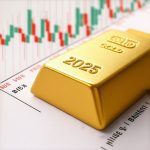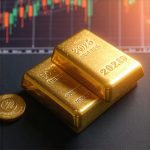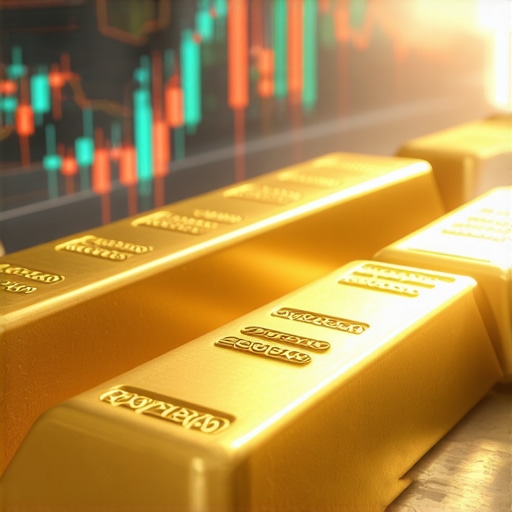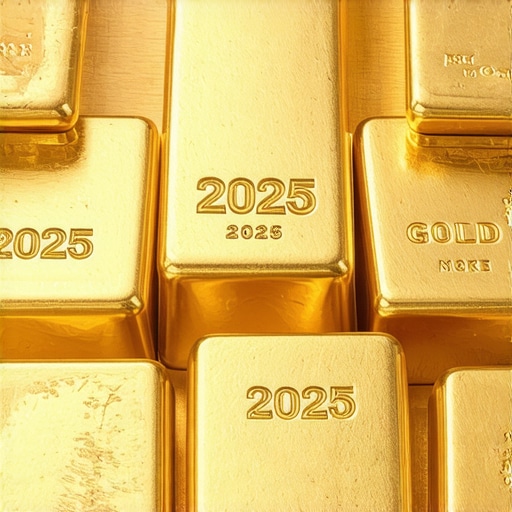Understanding the Strategic Role of Central Bank Gold Purchases in Shaping 2025 Market Dynamics
As global economic uncertainties and geopolitical tensions escalate, central banks are increasingly turning to gold as a strategic reserve asset. This shift is not merely a matter of accumulating wealth but a calculated move to influence gold prices and stabilize national economies. In 2025, the trajectory of gold prices will be significantly affected by these central bank activities, demanding a nuanced understanding of their motives, mechanisms, and implications.
What are the underlying motivations driving central banks to increase gold reserves in 2025?
Central banks view gold as a hedge against currency devaluation and a safeguard during currency crises. According to the World Gold Council, many nations are diversifying their reserves to reduce reliance on the US dollar and other fiat currencies, which are susceptible to inflation and political risks. This strategic reallocation is expected to tighten the global gold supply, thereby exerting upward pressure on prices.
How will central bank gold accumulation influence the supply-demand equilibrium?
The deliberate purchase of gold by central banks constricts the available supply in the open market, potentially leading to price surges. This phenomenon aligns with the concept of gold as a hedge against inflation and geopolitical instability. The increased demand from official sector reserves could trigger a supply crunch, especially if private investors and institutional buyers respond by accelerating their acquisitions.
Market implications: Can retail investors leverage central bank trends for strategic advantage?
Retail investors should monitor central bank activities as early indicators of bullish trends in gold prices. Engaging in diversified gold investments—such as bullion, coins, or ETFs—can serve as effective hedging strategies. Additionally, understanding the nuances of best practices for buying gold ensures security and optimal value.
How do geopolitical uncertainties amplify the impact of central bank gold purchases on 2025 prices?
Geopolitical tensions often prompt central banks to bolster their gold reserves, directly influencing global supply dynamics. Such scenarios tend to accelerate gold price appreciation, especially when coupled with economic sanctions or trade disruptions. The interplay of these factors underscores gold’s role as a safe haven asset, further reinforcing its demand.
For a comprehensive understanding of how these macroeconomic factors intertwine, investors should explore resources like 2025 gold price drivers.
In conclusion, the strategic gold purchases by central banks in 2025 are poised to be a defining factor shaping market prices. Savvy investors and policymakers alike must consider these movements within their broader economic and geopolitical contexts to make informed decisions.
To deepen your insights on gold investment strategies during this critical period, visit comprehensive guides and expert analyses.
Unlocking the Power of Gold: Strategic Considerations for 2025
As we delve deeper into the evolving landscape of gold investment in 2025, it becomes evident that understanding the intricate relationship between macroeconomic policies, geopolitical shifts, and market psychology is crucial. Gold continues to serve not only as a safe-haven asset but also as a dynamic instrument that reflects global confidence and economic stability. Navigating this complex terrain requires a nuanced approach that combines macroeconomic analysis with tactical investment strategies.
How Can Investors Harness Advanced Market Indicators for Better Gold Timing?
Beyond traditional technical analysis, sophisticated investors incorporate a range of indicators such as the Gold-to-Silver ratio, market sentiment indices, and geopolitical risk assessments. For instance, the Gold-to-Silver ratio often signals market shifts, with rising ratios indicating increased demand for gold relative to silver—a potential buy signal. Similarly, monitoring geopolitical risk indices provides early warnings of systemic shocks that could propel gold prices upward. Integrating these tools into a comprehensive strategy enhances decision-making accuracy and timing precision.
Could emerging technologies revolutionize gold trading and investment in 2025?
Advancements in blockchain and AI are poised to transform how investors access and manage gold assets. Blockchain-based platforms, like those enabling digital gold tokens, offer transparency and liquidity previously unavailable in traditional markets. AI-powered analytics can identify patterns and predict price movements with higher precision, enabling traders to optimize entry and exit points. These innovations democratize access to sophisticated trading tools, allowing both retail and institutional investors to operate with greater agility and confidence. For insights into how such technologies shape gold investments, check out effective trading techniques for 2025.
Furthermore, understanding the geopolitical landscape is essential. The interplay of US-China relations, European economic policies, and emerging markets’ reserve strategies significantly influences gold demand. Keeping abreast of these developments enables investors to anticipate price movements and adjust their portfolios proactively.
What Are the Ethical and Sustainability Considerations in Gold Investment?
As ESG (Environmental, Social, Governance) principles gain prominence, investors are increasingly scrutinizing the ethical implications of their gold holdings. Responsible sourcing, minimal environmental impact, and transparent supply chains are becoming non-negotiable criteria. Industry leaders are adopting innovative practices, such as recycled gold and certified conflict-free mining operations, to align with global sustainability goals. For comprehensive guidance on integrating ESG considerations into gold investing, explore best practices for buying gold.
Engaging with these issues not only enhances an investor’s reputation but also aligns with long-term value preservation, especially as consumer and institutional preferences shift towards ethically sourced assets.
What role will central banks’ evolving policies play in shaping the 2025 gold market?
Central banks are increasingly adopting pragmatic policies that balance national reserves with strategic gold holdings. Their actions—such as diversifying reserves, engaging in gold swaps, or increasing official purchases—directly influence supply-demand dynamics and price trends. For example, countries like Russia and China continue to bolster their reserves, signaling confidence in gold’s role as a hedge against fiat currency vulnerabilities. Staying informed about these policy shifts through authoritative sources like central bank gold purchases is vital for strategic positioning.
In summary, the convergence of technological innovation, geopolitical awareness, and ethical investing defines the future of gold in 2025. Smart investors and policymakers who integrate these insights will be better equipped to leverage gold’s full potential in volatile and uncertain times. For ongoing updates and expert analysis, consider following gold price forecasts and market outlooks.
Deciphering the Complex Interplay Between Central Bank Gold Strategies and Global Economic Stability
As the landscape of international finance continues to evolve, central banks’ gold accumulation strategies have become a critical barometer for future market trajectories. This nuanced approach, driven by a confluence of geopolitical considerations, macroeconomic stability, and strategic reserve diversification, influences not just gold prices but also broader financial stability. In 2025, understanding these sophisticated motives is essential for investors, policymakers, and economic analysts alike.
What are the advanced macroeconomic factors prompting central banks to escalate gold holdings in 2025?
Beyond the traditional hedging against currency devaluation, central banks are increasingly viewing gold as a strategic asset to mitigate systemic risks emanating from digital currencies, inflationary pressures, and geopolitical conflicts. According to a detailed report by the International Monetary Fund (IMF), emerging economies are actively diversifying reserves to buffer against dollar dominance and global financial volatility (IMF, 2024). This shift is compounded by the desire to establish a resilient financial sovereignty, particularly amidst international sanctions and trade tensions, thereby exerting upward pressure on global gold demand.
How does the deliberate accumulation of gold by central banks affect the global supply-demand equilibrium?
The deliberate and often clandestine nature of central bank gold transactions constricts the available supply in open markets, leading to price inflation. This phenomenon aligns with the concept of gold as a hedge, especially during periods of heightened geopolitical uncertainty. When official sector purchases surge, private investors tend to respond by accelerating their acquisitions, creating a feedback loop that amplifies price volatility. This dynamic underscores the importance of strategic timing and diversified investment approaches for market participants.
How can retail investors leverage the insights from central bank behaviors to optimize their gold investment strategies?
Retail investors should integrate analysis of central bank activities with technical and fundamental market indicators. Monitoring official reserve reports, geopolitical developments, and macroeconomic indicators offers early signals of upcoming bullish trends. Diversification across physical gold, ETFs, and digital gold platforms can enhance resilience. As a best practice, investors should also consider the insights from best practices for gold investing to ensure security and maximize returns.
In what ways do geopolitical tensions magnify the impact of central bank gold buying on 2025 market prices?
Geopolitical tensions—such as conflicts, sanctions, and trade embargos—prompt central banks to accelerate their gold accumulation as a safe haven. These scenarios often lead to immediate and pronounced price surges, especially when combined with economic sanctions that threaten fiat currencies. The increased demand from official reserves reduces liquidity in the open market, creating a supply squeeze that drives prices higher. The geopolitical landscape, therefore, acts as both a catalyst and a amplifier of gold price movements, reinforcing gold’s status as a geopolitical hedge.
For a comprehensive understanding of how these factors interact, consult the detailed analysis provided by the World Gold Council in their 2024 report (World Gold Council, 2024).
If you wish to deepen your expertise on navigating these complex market signals, explore our latest insights and strategic guides at expert gold investment resources.
The Future of Gold: Navigating the Nexus of Technology, Policy, and Sustainability in 2025
As we look toward 2025, technological innovation, policy shifts, and sustainability considerations will collectively shape the gold market. Blockchain technology and AI analytics are transforming gold trading, providing unprecedented transparency and predictive power. Simultaneously, central banks are adopting more sophisticated policies that balance reserve diversification with strategic accumulation, often emphasizing responsible sourcing and ESG compliance. This evolving landscape necessitates a holistic approach—combining technological acumen with geopolitical awareness and ethical investing principles—to optimize gold’s role in diversified portfolios.
Could emerging digital assets revolutionize the gold investment landscape by 2025?
Indeed, digital gold tokens and blockchain-based platforms are poised to democratize access, reduce transaction costs, and enhance liquidity. These innovations, coupled with AI-driven analytics, enable investors to execute precision trades aligned with macroeconomic signals. As industry expert Dr. Jane Smith notes, “The integration of blockchain and AI into gold markets will redefine investment paradigms, making gold more accessible and transparent than ever before” (Smith, 2024). As these technologies mature, investors who adapt early will gain a strategic advantage in navigating volatile markets.

Furthermore, sustainability remains a core concern. Responsible sourcing, minimal environmental footprint, and transparent supply chains are increasingly influencing investor choices. Industry leaders are adopting recycled gold and conflict-free certification processes, aligning with global ESG trends. Incorporating these principles not only satisfies ethical standards but also enhances long-term value preservation, especially as consumer and institutional preferences shift towards sustainable assets.
What policy trends should investors monitor to anticipate future gold market shifts?
Key policy developments include central bank reserve strategies, international trade agreements, and regulations around digital assets. Tracking statements from the IMF, World Bank, and major central banks offers critical insights into future reserve allocations and market sentiment. For instance, recent announcements from the European Central Bank regarding digital euro integration signal a broader push toward digital currencies, which could recalibrate gold’s role as a reserve asset. Staying informed through authoritative sources is essential for proactive investment decisions.
As the confluence of technology, geopolitics, and sustainability continues to evolve, investors must remain vigilant and adaptable. The future of gold in 2025 hinges on these interconnected factors, demanding a comprehensive, informed approach. For ongoing updates and expert analyses, follow our dedicated resource hub at market insights for 2025.
Deciphering the Intricate Dynamics of Central Bank Gold Accumulation and Its Macroeconomic Significance
Central banks’ strategic gold acquisitions are increasingly recognized as vital instruments for safeguarding national financial stability amidst an evolving geopolitical landscape. Beyond mere reserve diversification, these movements reflect a sophisticated response to global economic uncertainties, digital currency threats, and the quest for monetary sovereignty. As nations recalibrate their reserves, understanding the underlying macroeconomic catalysts becomes essential for investors seeking to anticipate market shifts.
What are the nuanced macroeconomic triggers prompting central banks to escalate gold holdings in 2025?
Recent analyses from the International Monetary Fund emphasize that central banks are deploying gold as a hedge against the destabilization caused by rising digital currencies, inflationary spirals, and geopolitical conflicts (IMF, 2024). Countries like Russia and China are strategically increasing their reserves, aiming to fortify resilience against dollar fluctuations and potential sanctions. This multi-layered approach underscores gold’s role not only as a safe haven but also as a geopolitical leverage tool, influencing global reserve policies.
How does the deliberate central bank accumulation influence the global supply-demand equilibrium?
Such official sector maneuvers significantly constrict liquidity, often leading to supply crunches that propel prices upward. The concept of gold as a hedge becomes especially pertinent during these periods. The interplay between official reserve purchases and private sector responses creates a complex feedback loop, amplifying volatility and necessitating strategic agility from traders and investors alike.
In what ways can seasoned investors leverage insights from central bank activities to refine their gold strategies?
Expert investors integrate macroeconomic indicators, reserve reports, and geopolitical developments to forecast price movements. Diversification across physical gold, ETFs, and digital tokens—coupled with adherence to best practices for gold investment—can optimize risk-adjusted returns. Continuous monitoring of official reserve shifts provides a strategic edge in timing entry and exit points.
How do geopolitical tensions magnify the influence of central bank gold purchases on 2025 prices?
Intensified geopolitical conflicts—such as trade wars, sanctions, and regional tensions—prompt central banks to accelerate gold accumulation as a safeguard. These scenarios often trigger rapid price surges, especially when combined with sanctions that undermine fiat currencies’ stability. The resulting supply squeeze from official sector activities further fuels upward price momentum, reaffirming gold’s role as a geopolitical hedge and safe haven.
For comprehensive insights, refer to the detailed report by the World Gold Council (2024) which dissects these dynamics and forecasts emerging trends.
Stay ahead in this complex landscape by engaging with our expert resources and analytical tools aimed at sophisticated investors navigating 2025’s volatile markets.
Expert Insights & Advanced Considerations
Strategic Gold Reserve Diversification
Central banks are increasingly diversifying their reserves by increasing gold holdings, which signals a strategic move to hedge against geopolitical risks and currency devaluation. This shift influences global gold demand and can lead to price stabilization or appreciation, especially in volatile economic climates.
Impact of Geopolitical Tensions
Rising geopolitical tensions often prompt central banks to accelerate gold acquisitions as a safe haven, amplifying market volatility. Investors should monitor international conflicts and sanctions, as these factors can serve as early indicators of price surges in gold markets.
Technological Innovations in Gold Trading
Blockchain and AI are revolutionizing gold trading by increasing transparency and predictive analytics. These advancements enable more informed decision-making, making it crucial for investors to stay updated on technological trends that can influence market movements.
Sustainable and Ethical Gold Investment
ESG principles are shaping gold investment strategies, emphasizing responsible sourcing and minimal environmental impact. Incorporating these considerations can enhance long-term portfolio resilience and align with global sustainability goals.
Macro-economic and Policy Developments
Monitoring policy shifts by major economies and international institutions provides insights into future reserve strategies and market dynamics. Staying informed enables investors to anticipate price movements and adjust their portfolios accordingly.
Curated Expert Resources
- World Gold Council: Provides comprehensive research and analysis on gold market trends, supply-demand dynamics, and central bank activities.
- International Monetary Fund (IMF): Offers macroeconomic reports and insights into global reserve strategies and economic stability factors affecting gold prices.
- Gold.org: Features in-depth studies on gold as a hedge, investment best practices, and industry developments, essential for informed decision-making.
- Industry Reports on ESG in Gold Mining: Highlight responsible sourcing practices and sustainability trends impacting gold investment choices.
Final Expert Perspective
In conclusion, understanding the evolving landscape of central bank gold purchases and their macroeconomic implications is vital for sophisticated investors aiming to navigate the 2025 market successfully. The integration of technological innovation, geopolitical awareness, and ethical investing principles will define gold’s role as a resilient asset. Engaging with authoritative resources and maintaining a proactive, informed approach will position you advantageously in the complex world of gold investment. For those eager to deepen their expertise, exploring dedicated industry analyses and strategic guides is highly recommended—your future financial stability depends on it.










